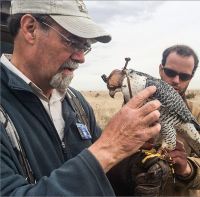The U.S. National Renewable Energy Laboratory (NREL) have enlisted an avian partner in research aiming to reduce bird fatalities caused by collisions with wind turbines – a Peregrine falcon named Houdini.
Although wind farms only account for a very small percentage of bird deaths in the States each year compared to the amount killed by habitat destruction by human beings, some of America’s larger raptor species, such as the rare and protected Golden Eagle, are more prone to colliding with turbines as they fly at the heights of large wind towers.
NREL scientists plan to equip 15-year-old Houdini with GPS tracking device that will bounce a signal off a radar station at the laboratory’s National Wind Technology Centre (NWTC). The idea is that Houdini’s flight pattern will teach the radar to spot birds among aircraft, cars, airborne litter and other atmospheric disturbances.
The alternative – according to project manager Ismael Mendoza – is to station a human being at the wind power plant 24 hours a day, seven days a week, to watch for birds.
Originally developed by Laufer Wind as an aircraft warning system, the complex radar automatically switches on lights atop wind turbines to warn pilots. These lights which would otherwise flash all night, annoying nearby residents. NREL researchers soon realised this capability could be tweaked to prevent bird strikes.
They began by using remote-controlled drones to simulate birds at the NWTC site, with the radar sweeping 360 degrees and tracking each drone in its flight. But after contacting a local hawking club, NREL Field Test Engineer Jason Roadman met up with Houdini’s handler, Sam Dollar, a falconer who heads the U.S. Air Force Academy’s falconry unit, and wows crowds with examples of Houdini’s prowess at Colorado Stadium football matches.
According to Roadman, Houdini’s short maiden flight wearing a trimmed-down version of the tracker was a success, and will enable the Laufer radar system to triangulate the blip of data generated by flying birds amidst the gigabytes collected around the wind turbines.
Houdini and Dollar will continue to work with the NREL on longer, more sustained flights in the future.
Roadman said the falcon project is a career highlight. “It sure beats staring at a spreadsheet full of numbers. One of the cool things about NREL is that every once in a while a project comes along to remind you why you are here.”







































